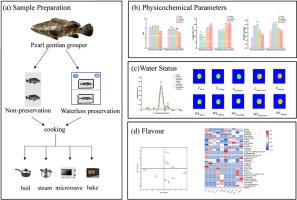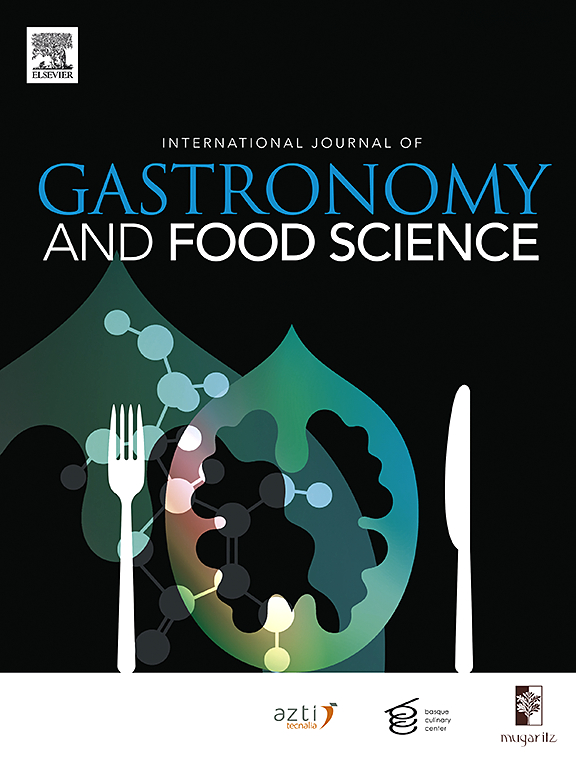无水保鲜热加工方法对珍珠龙胆石斑鱼理化特性和风味相关化合物的影响
IF 3.2
2区 农林科学
Q2 FOOD SCIENCE & TECHNOLOGY
International Journal of Gastronomy and Food Science
Pub Date : 2024-10-26
DOI:10.1016/j.ijgfs.2024.101049
引用次数: 0
摘要
本研究探讨了各种处理(煮、蒸、微波加热和烘烤)对珍珠龙胆石斑鱼无水保鲜后的理化性质和风味特征的影响。经 Csteaming(非保鲜蒸煮处理)和 WLsteaming(无水保鲜蒸煮处理)处理的石斑鱼肉弹牙度最高(P < 0.05)。此外,蒸煮和无水蒸煮显著降低了硬度和蒸煮损失(P < 0.05),并显示出最高的鲜味值。与其他热处理组相比,烘焙组的 TBARS 值明显较低(P < 0.05)。加热石斑鱼样品中的主要挥发性化合物是氧化氮、硫化物和长链烷烃。顶空固相微萃取气相色谱-质谱法测定了加热石斑鱼样品中的挥发性风味化合物,共鉴定出 35 种挥发性化合物,包括 8 种醛、8 种醇、1 种酸、5 种含氮化合物、6 种碳氢化合物和 7 种酮。煮沸处理的 5′-IMP 和乳酸含量最高。同时,蒸煮处理是保持鲜味的首选方法。此外,无水保存技术有效提高了珍珠龙胆石斑鱼中琥珀酸的含量。本文章由计算机程序翻译,如有差异,请以英文原文为准。

Impact of thermal processing methods on physicochemical properties and flavor-related compounds of Pearl gentian grouper with waterless preservation
This study investigated the impact of various treatments (boiling, steaming, microwave heating, and baking) on the physicochemical properties and flavor profile of pearl gentian grouper after undergoing waterless preservation. The grouper meat treated with Csteaming (non-preservation steaming treatment) and WLsteaming (waterless preservation steaming treatment) exhibited the highest levels of springiness (P < 0.05). Additionally, Csteaming and WLsteaming significantly reduced the hardness and cooking loss (P < 0.05) and demonstrated the highest umami values. The TBARS value of the baking groups exhibited a significantly lower level compared to that of the other heat treatment groups (P < 0.05). The primary volatile compounds in the heated grouper samples were nitrogen oxide, sulfides, and long-chain alkanes. The volatile flavor compounds of heated grouper samples were determined by headspace solid-phase microextraction gas chromatography-mass spectrometry, and a total of 35 volatile compounds were identified, including 8 aldehydes, 8 alcohols, 1 acid, 5 nitrogen-containing compounds, 6 hydrocarbons, and 7 ketones. The boiling treatments exhibited the highest levels of 5′-IMP and lactic acid. Meanwhile, steaming treatment emerged as a preferred method for maintaining the umami taste. Additionally, the waterless preservation technique effectively enhanced the content of succinic acid in pearl gentian grouper.
求助全文
通过发布文献求助,成功后即可免费获取论文全文。
去求助
来源期刊

International Journal of Gastronomy and Food Science
Social Sciences-Cultural Studies
CiteScore
5.30
自引率
10.50%
发文量
170
审稿时长
45 days
期刊介绍:
International Journal of Gastronomy and Food Science is a peer-reviewed journal that explicitly focuses on the interface of food science and gastronomy. Articles focusing only on food science will not be considered. This journal equally encourages both scientists and chefs to publish original scientific papers, review articles and original culinary works. We seek articles with clear evidence of this interaction. From a scientific perspective, this publication aims to become the home for research from the whole community of food science and gastronomy.
IJGFS explores all aspects related to the growing field of the interaction of gastronomy and food science, in areas such as food chemistry, food technology and culinary techniques, food microbiology, genetics, sensory science, neuroscience, psychology, culinary concepts, culinary trends, and gastronomic experience (all the elements that contribute to the appreciation and enjoyment of the meal. Also relevant is research on science-based educational programs in gastronomy, anthropology, gastronomic history and food sociology. All these areas of knowledge are crucial to gastronomy, as they contribute to a better understanding of this broad term and its practical implications for science and society.
 求助内容:
求助内容: 应助结果提醒方式:
应助结果提醒方式:


